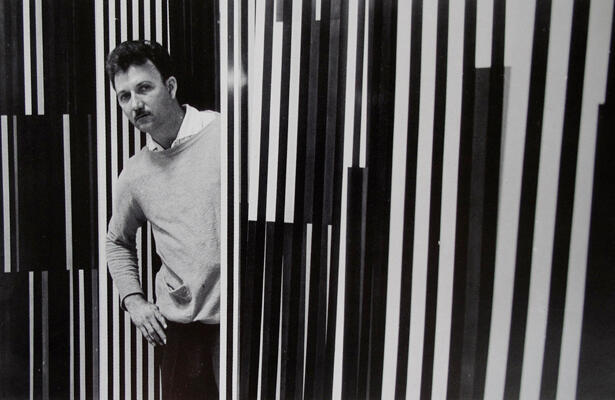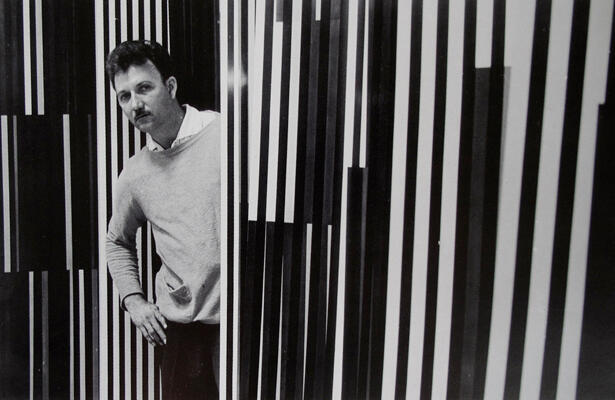IAC Presents O Espaço Ressoante. Os Colorítmos de Alejandro Otero
Instituto de Arte Contemporânea (IAC) is proud to present O Espaço Ressoante. Os Colorítmos de Alejandro Otero (Resonant Space: The Colorhythms of Alejandro Otero).

On view from September 3, 2012 through January 6, 2013, this exhibition was organized by IAC in partnership with Fundação Nemirovsky and Pinacoteca do Estado de São Paulo. Curated by Rina Carvajal, this exhibition will be the first outside of the artist’s native Venezuela dedicated to the Colorhythms, and the first important one-man exhibition for this artist in Brazil. A major artistic reference in the history of abstraction, Alejandro Otero (Venezuela, 1921–1990) is renowned as a painter and sculptor. In his art, he developed a lucid and coherent investigation, which allowed him to gradually work through artistic problems, exhausting their possibilities and driving them to their ultimate compositional consequences. Between 1955 and 1960, he developed the extraordinary series of seventy-five Colorhythms, one of his major conceptual contributions to the field of painting.
Otero studied at the Escuela de Artes Plásticas de Caracas (School of Fine Arts of Caracas) from 1939 to 1945. From then until 1952, he lived in Paris, returning to Venezuela only briefly. During these years he became deeply engaged in studying the work of Piet Mondrian and produced some of his most important pictorial series. Between 1946 and 1948 he painted Las Cafeteras (The Coffee Pots), a body of work that marks his transition from figuration to abstraction. Surrounded by controversy, this series was exhibited in 1949 in Caracas, triggering the emergence of abstraction and modern art in Venezuela.
In 1951, Otero embarked on two new series of works : the Líneas de color sobre fondo blanco (Colored Lines on a White Background) of 1951 and the Collages ortogonales (Orthogonal Collages) of 1951–52. It is in these works that the idea of the module first emerged in Otero’s practice, and in which he exhaustively explored a dynamic conception of space and of two-dimensional structure. The spatial emphasis in these works led Otero to consider the need for a format “different from the two-dimensionality of canvas and paper,” and to imagine possibilities made available by architecture. This new interest drew Otero back to Caracas, where a new and important architectural movement was beginning. Upon his return, Otero came into contact with some of the architects involved in this movement, and soon after he was invited to participate in the project of integrating the visual arts in the architectural program of the Ciudad Universitaria de Caracas (Universidad Central de Venezuela) [University City of Caracas (Central University of Venezuela)], a project directed and promoted by the architect Carlos Raúl Villanueva, and considered the most advanced effort in architecture and urbanism in the country.
As part of large group of Venezuelan and foreign artists (including Mateo Manaure, Francisco Narváez, Jesús Rafael Soto, Alexander Calder, Fernand Léger, Jean Arp, and Victor Vasarely) contributing to the project, Otero realized a series of large-scale public works: the murals and stained glass windows of the School of Engineering (1954), and Policromías (Polychromies), facades in glass mosaic on the School of Architecture (1956) and the School of Pharmacy (1957).
In 1955, Otero produced his first Colorhythms through a constructive process that integrated different types of space into a single pictorial plane. In these works, he questioned the very idea of painting as object and incorporated painting’s potentially architectonic space. These works, as Otero himself wrote, “overflow the plane, they reach for architectural space and embrace it.” With the Coloryhthms, Otero proposed an idea of particular importance: the notion of the plane as a spatial field of forces in expansion, functioning simultaneously as painting, volume, and architecture.
Painted with Duco, a shiny industrial lacquer, applied with spray guns or rollers on wood or Plexiglas, the Colorhythms are large-scale compositional modules executed on rectangular support structures. Structured by parallel, evenly spaced dark vertical bands on white grounds, the paintings have color markings placed between the bands, which activate the entire structure of the plane. In these works, Otero succeeded in emphasizing rhythm and color over form, resulting in a suggestive spatial ambiguity. With great rigor and visual dynamism, Otero articulates a complex weaving of linear, spatial, and color rhythms and tensions. The “directionally open rhythm” expands toward the exterior of the painting.
Otero developed the first Colorhythms by means of black and white bands, and pure and brilliant color accents. The color accents between the dark lines produce vibrations and generate a dialogue between dimensions, rhythms, and spaces. In later Colorhythms, he transformed the color accents into elongated rectangles, establishing a more open scheme in which the bands, divested of continuity, seem to form a solid block. While the first Colorhythms drew the spectator’s gaze toward the interior of the plane, subsequent panels take it from the plane toward the space beyond it.
Otero’s work has been included in four International Biennials in São Paulo (1957, 1959, 1963, 1991), garnering an Honorable Mention in the Fifth Biennial in 1959. It was featured as well in the 2007 Mercosul Biennial in Porto Alegre, yet Brazil has never seen a focused exhibition that would allow us to evaluate the place of the Colorhythms within his work and within the context of international geometric abstraction.
Rina Carvajal is an independent curator and critic based in Miami. She is presently a guest curator for the Instituto de Arte Contemporânea (IAC) and the Instituto Moreira Salles (Brazil). Until 2011, she served as Adjunct Curator for the Miami Art Museum. She was guest curator for the 29th São Paulo Biennial (2010). Carvajal was previously the Director and Chief Curator of Miami Art Central (Miami).
Estação Pinacoteca
Largo General Osório, 66, São Paulo – CEP 01213-010
Tel: (11) 3335.4990
-
 Coloritmo N˚ 10, 1956
Coloritmo N˚ 10, 1956
Duco sobre madera
186 x 50 x 3 cm
Cole Marianne Vegas Bandt y Manuel Vegas Bandt
Fotografía: Joaquín Cortés, España
Cortesía de Alejandro J. Otero, Mercedes Otero Pardo, Gil F. Otero Pardo y Carolina Otero Pardo
-
 en el Museo de Bellas Artes, Caracas (Alejandro Otero in the Museo de Bellas Artes), 1960
en el Museo de Bellas Artes, Caracas (Alejandro Otero in the Museo de Bellas Artes), 1960 -
 Coloritmo N˚66, 1966 - Duco sobre madera - 200 x 50 cm
Coloritmo N˚66, 1966 - Duco sobre madera - 200 x 50 cm
Colección Ella Fontanals-Cisneros, Miami, FL
Cortesía de Alejandro J. Otero, Mercedes Otero Pardo, Gil F. Otero Pardo y Carolina Otero Pardo




